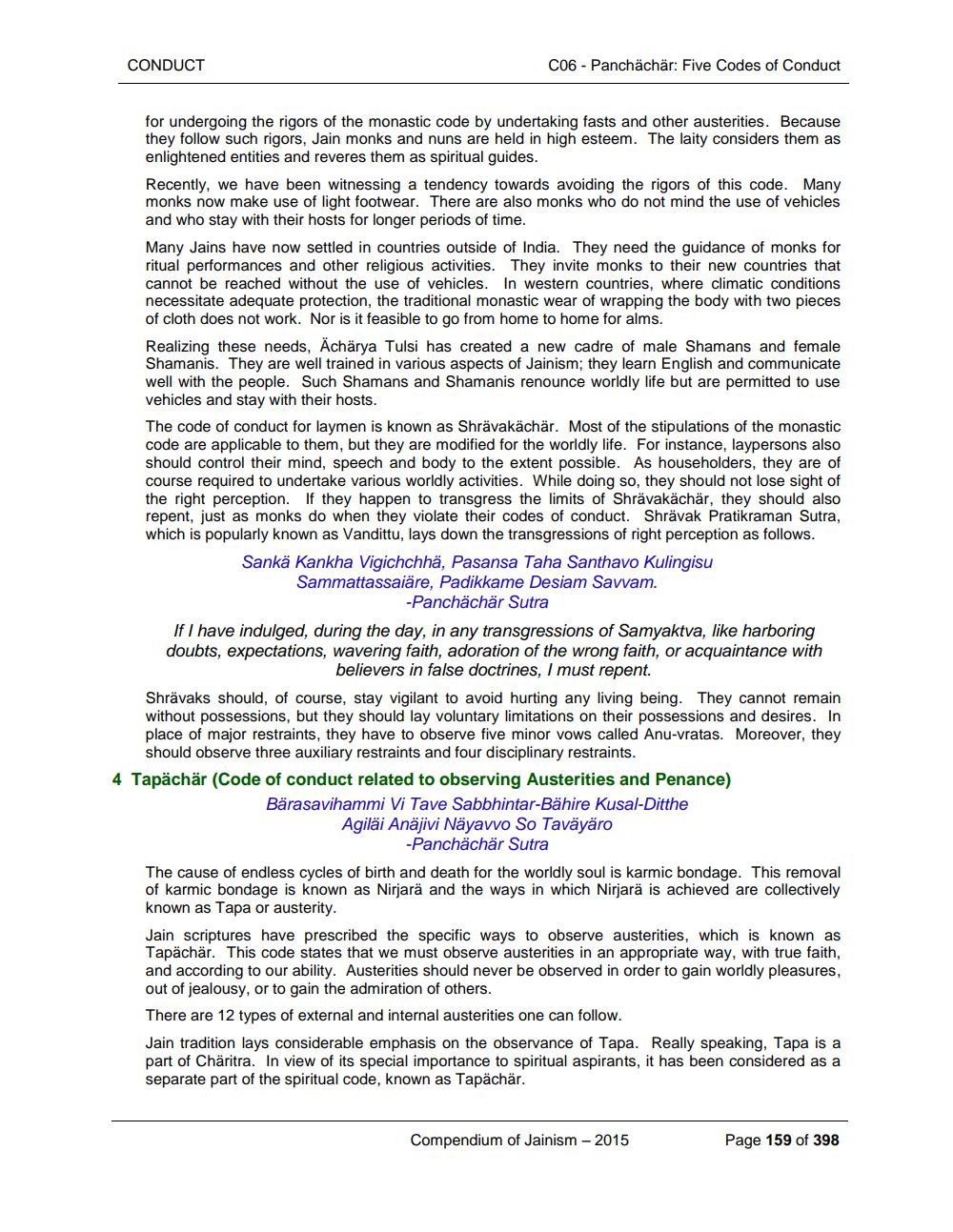________________
CONDUCT
C06 - Panchächär: Five Codes of Conduct
for undergoing the rigors of the monastic code by undertaking fasts and other austerities. Because they follow such rigors, Jain monks and nuns are held in high esteem. The laity considers them as enlightened entities and reveres them as spiritual guides. Recently, we have been witnessing a tendency towards avoiding the rigors of this code. Many monks now make use of light footwear. There are also monks who do not mind the use of vehicles and who stay with their hosts for longer periods of time. Many Jains have now settled in countries outside of India. They need the guidance of monks for ritual performances and other religious activities. They invite monks to their new countries that cannot be reached without the use of vehicles. In western countries, where climatic conditions necessitate adequate protection, the traditional monastic wear of wrapping the body with two pieces of cloth does not work. Nor is it feasible to go from home to home for alms. Realizing these needs, Acharya Tulsi has created a new cadre of male Shamans and female Shamanis. They are well trained in various aspects of Jainism; they learn English and communicate well with the people. Such Shamans and Shamanis renounce worldly life but are permitted to use vehicles and stay with their hosts. The code of conduct for laymen is known as Shrävakächär. Most of the stipulations of the monastic code are applicable to them, but they are modified for the worldly life. For instance, laypersons also should control their mind, speech and body to the extent possible. As householders, they are of course required to undertake various worldly activities. While doing so, they should not lose sight of the right perception. If they happen to transgress the limits of Shrävakächär, they should also repent, just as monks do when they violate their codes of conduct. Shravak Pratikraman Sutra, which is popularly known as Vandittu, lays down the transgressions of right perception as follows.
Sankä Kankha Vigichchhä, Pasansa Taha Santhavo kulingisu Sammattassaiäre, Padikkame Desiam Savvam.
-Panchächär Sutra If I have indulged, during the day, in any transgressions of Samyaktva, like harboring doubts, expectations, wavering faith, adoration of the wrong faith, or acquaintance with
believers in false doctrines, I must repent. Shrävaks should, of course, stay vigilant to avoid hurting any living being. They cannot remain without possessions, but they should lay voluntary limitations on their possessions and desires. In place of major restraints, they have to observe five minor vows called Anu-vratas. Moreover, they
should observe three auxiliary restraints and four disciplinary restraints. 4 Tapächär (Code of conduct related to observing Austerities and Penance)
Bärasavihammi Vi Tave Sabbhintar-Bähire Kusal-Ditthe Agiläi Anäjivi Näyavvo So Taväyäro
-Panchächär Sutra The cause of endless cycles of birth and death for the worldly soul is karmic bondage. This removal of karmic bondage is known as Nirjarä and the ways in which Nirjarä is achieved are collectively known as Tapa or austerity. Jain scriptures have prescribed the specific ways to observe austerities, which is known as Tapächär. This code states that we must observe austerities in an appropriate way, with true faith, and according to our ability. Austerities should never be observed in order to gain worldly pleasures, out of jealousy, or to gain the admiration of others. There are 12 types of external and internal austerities one can follow. Jain tradition lays considerable emphasis on the observance of Tapa. Really speaking, Tapa is a part of Charitra. In view of its special importance to spiritual aspirants, it has been considered as a separate part of the spiritual code, known as Tapächär.
Compendium of Jainism - 2015
Page 159 of 398




